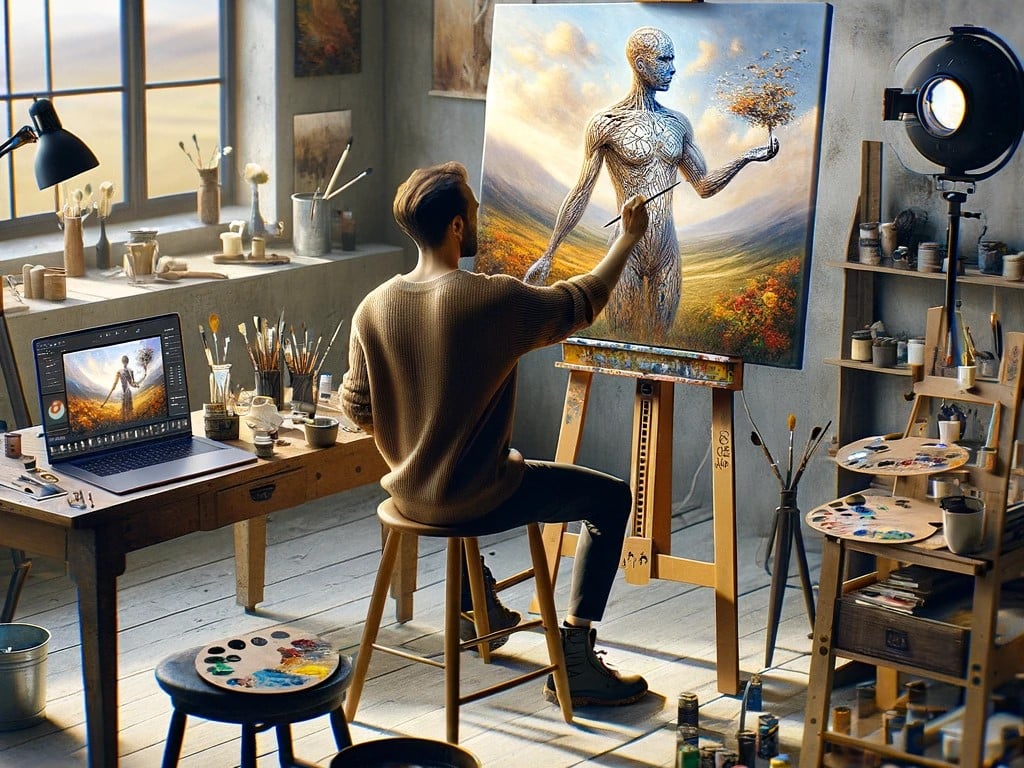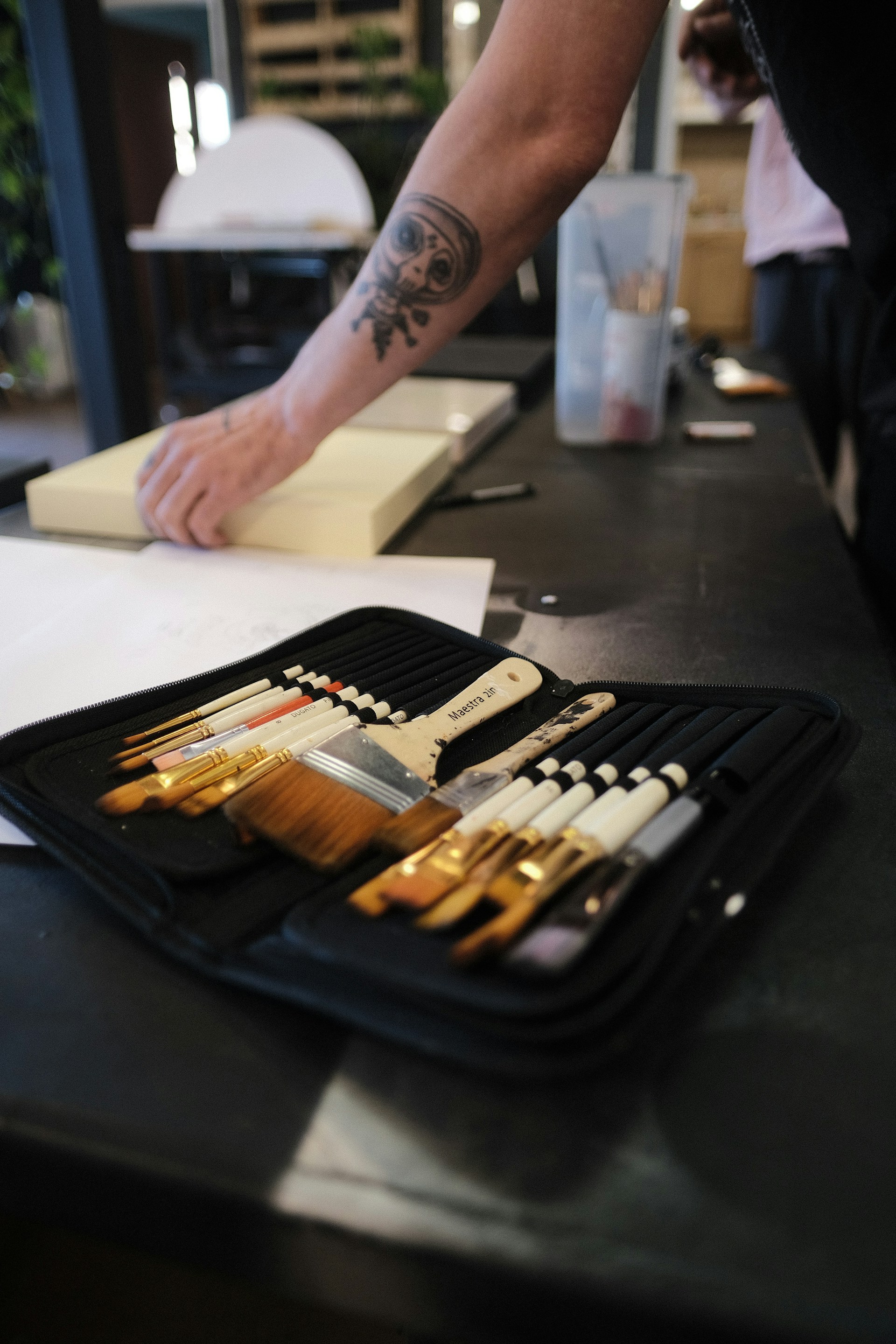The intersection of artificial intelligence (AI) and creative fields marks a revolutionary leap in how art is conceived, created, and consumed. From painting and music to literature and photography, AI’s capabilities are being harnessed to push the boundaries of traditional creativity.
Among these innovations, AI photo apps stand out, exemplifying the remarkable potential of technology to democratize and innovate art creation. However, this technological marvel does not come without its complications. The rise of AI in art has ignited a complex debate surrounding ethics, originality, and the very nature of creativity.
This article delves into the dual-edged sword of AI in creative fields, exploring the balance between unleashing creative potential and navigating the ethical quandaries that arise, ultimately suggesting a path towards responsible creativity in the age of digital innovation.
IMAGE: OPTICOUS
The Evolution of AI in Creativity
The journey from brush and canvas to pixels and algorithms narrates the evolution of art through ages. The digital era, marked by rapid technological developments, has set the stage for AI to become a pivotal force in creative industries.
AI photo apps, leveraging sophisticated algorithms to edit, enhance, or entirely generate visual content, exemplify this transition. These tools range from simple photo filters to complex software capable of producing images indistinguishable from those captured by human hands and eyes.
The impact of such technology on the art industry is profound. Artists, photographers, and designers now have access to tools that can amplify their creativity, enabling the production of work that was previously unimaginable. For instance, AI can generate intricate patterns and textures, or simulate different artistic styles, offering endless possibilities for creative exploration.
However, this innovation also introduces disruptions. Traditional skills and techniques risk being overshadowed by the efficiency and novelty of AI-generated art, raising questions about the future role of human artists.
Ethical Considerations in AI-Generated Art
As AI continues to blur the lines between technology and creativity, it ushers in a host of ethical considerations that challenge our traditional understanding of art and its creation. One of the most pressing concerns revolves around intellectual property rights.
The question of who holds the copyright to an AI-generated piece—the creator of the AI, the user who prompted the creation, or the AI itself—remains largely unsettled. This ambiguity complicates the legal landscape of art, potentially stifling innovation or unfairly benefiting certain stakeholders over others.
To further explore the ethical dimensions of AI in art, the following video, ‘AI Ethics, Artists, and What You Can Do About It,’ offers insightful perspectives from artists and ethicists. It delves into how AI challenges traditional notions of creativity and ownership, enriching our discussion on intellectual property rights within the digital art sphere.
Moreover, the authenticity of creation comes under scrutiny. The art world values originality and individual expression, qualities traditionally ascribed to human creators. When an AI produces art, it raises debates over whether these works can be considered ‘authentic’ or if they merely mimic human creativity.
Critics argue that AI-generated art lacks the intentional, emotional depth that comes from human experience, while proponents see it as an extension of human creativity through technological means.
Privacy concerns also emerge, particularly with AI apps that manipulate personal images. The unauthorized use of personal data without consent not only breaches privacy but also raises questions about the ethical use of images in creating art.
Additionally, the potential for AI to reflect or perpetuate societal biases—whether through the data it’s trained on or the preferences programmed by its developers—calls for a careful examination of how these technologies are designed and employed.
The Creativity Controversy: AI vs. Human Ingenuity
The integration of AI into the creative process sparks a controversy over the value and uniqueness of human creativity. On one hand, AI is celebrated for its ability to enhance human creativity, offering tools that unlock new forms of expression and artistic possibilities.
AI can process huge amounts of data, learn from existing art, and generate complex compositions that would be time-consuming or impossible for humans to create alone. On the other hand, there’s a fear that AI could devalue human effort and creativity.
If art can be generated at the click of a button, what becomes of the skills, emotions, and personal experiences that artists have traditionally poured into their work? This concern is not just philosophical but practical, as the proliferation of AI-generated art could impact the livelihoods of artists and the way art is valued and consumed.
Case studies in both the success and controversy of AI-generated art abound. From AI algorithms that have won art competitions to those embroiled in copyright disputes, these examples highlight the complex interplay between innovation and tradition, technology and human creativity.
Toward Responsible Creativity: Balancing Innovation with Ethics
The challenges posed by AI in the arts call for a balanced approach that fosters innovation while addressing ethical concerns. The Establish of guidelines for the ethical use of AI in art is crucial. This includes principles of transparency, where the involvement of AI in the creative process is clearly disclosed.
Consent and attribution are also key, ensuring that data used by AI, especially when involving personal images, is gathered ethically and creators are properly credited for their work.
Policy and regulation play a significant role in navigating the ethical landscape of AI-generated art.
Governments and industry bodies worldwide are beginning to recognize the need for legal frameworks that address copyright issues, privacy, and bias in AI. These regulations should aim to protect the rights of creators and subjects alike, while also encouraging the responsible development and use of AI technologies.
Moreover, fostering a collaborative future where artists and AI coexist creatively is essential. Rather than viewing AI as a substitute for human creativity, it should be seen as a tool that can augment and extend the capabilities of artists. Workshops, collaborations, and open dialogues between technologists and artists can help demystify AI and explore its potential in a manner that respects and enhances human creativity.
Conclusion
The advent of AI in creative fields presents a dual-edged sword, offering unprecedented opportunities for innovation while raising complex ethical questions. Navigating the ethics of AI in art requires a nuanced understanding of the interplay between creativity and controversy.
By addressing the challenges of copyright, authenticity, privacy, and bias, and by fostering an environment of responsible creativity, the art world can embrace the benefits of AI while upholding the values that make art profoundly human. As we move forward, it’s crucial for artists, technologists, and policymakers to work together to shape a future where AI enhances rather than eclipses human creativity.
The journey of integrating AI into the arts is just beginning, and its success will depend on our collective ability to navigate the ethical dilemmas it presents. In doing so, we can secure that AI serves as a catalyst for innovation, pushing the boundaries of what’s possible in art while respecting the creative spirit that defines us.
IMAGE: UNSPLASH
If you are interested in even more entertainment-related articles and information from us here at Notilizer, then we have a lot to choose from.


COMMENTS